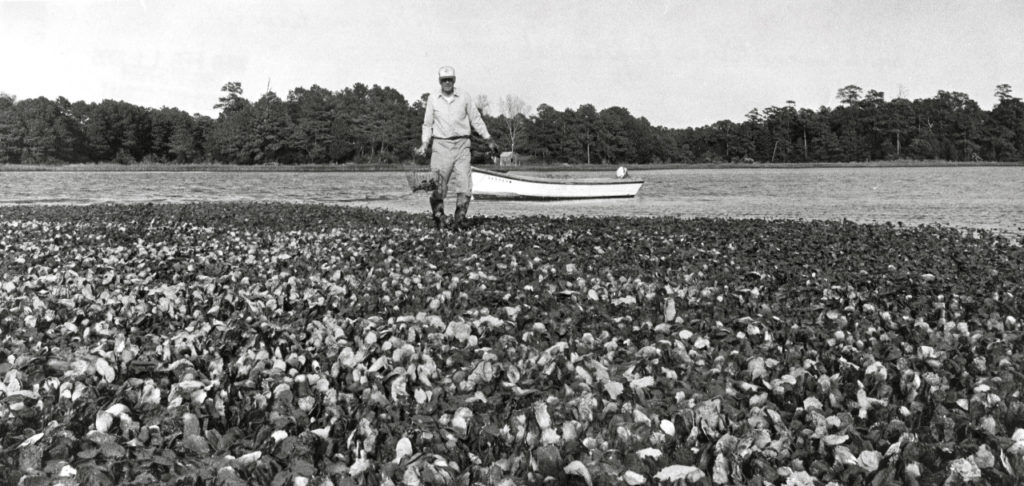
By Mary Reid Barrow
After last week’s blog on the risks that oysters on intertidal reefs face in freezing weather, I followed up with Brent James, LRNow’s oyster restoration coordinator, about the intertidal oyster reefs in general on the Lynnhaven River.
Intertidal reefs are those reefs, that, when the tide is high, the reef is under water and when the tide is low, a lot of the reef is exposed to air. In the photo from the Virginian-Pilot years ago, oysterman Irvin Evans harvests the bivalves at a low tide on his intertidal reef.
Did our river have a lot of these intertidal reefs in the old days, I wondered, even though Virginia Beach is a little further north than most intertidal reef areas on the east coast?
Turns out, oysters in the Lynnhaven River waterways traditionally have been intertidal. In addition the easy access to the oysters that intertidal reefs provide may have contributed to the decline of the famed Lynnhaven oysters years ago.
“In historic terms, more than 1,000 acres of natural oyster reefs, were intertidal,” James said.
Most of the remaining subtidal acres are in Broad and Linkhorn bays, he added.
Because of the number of intertidal reefs scattered all over the Lynnhaven River system, in the good old days, folks could just walk out on the reefs at low tide and gather oysters at will.
”Both oystermen and regular folks would take basketfuls from the exposed reefs daily until eventually they were severely affected,” James said.
It looks like over harvesting may have been the start of the decline of the Lynnhaven oyster in the 1900s before the problems of pollution and run-off also took their toll.
Those were the days when Lynnhaven oysters were in great demand. They were known up and down the east coast for their delicious sweet-salty taste. The poor oysters became victims of their own deliciousness and ease of harvest.
Then in the mid-1900sVirginia Beach grew rapidly. Homes and streets and roads with big storm drains that drained to the river were built all over the northern part of the city. There were no environmental protections to speak of, Brent said, and the oysters took it on the chin.
“Massive amounts of runoff from bare lots and streets suffocated the intertidal reefs because they were the first place it accumulated, “ he explained,
He recalled building a dock in the water behind his house on the Eastern Branch of the Lynnhaven several years ago.
“When I was putting in the pilings for my dock,” he said, “I dug through 3 to 4 feet of muck and then hit 2-foot thick layers of oyster shells that had been buried by runoff and suffocated.”
To add insult to injury, the oysters on reefs that did not get suffocated and were still alive were un-harvestable. They were inedible, polluted by everything from automobile gas and oil run-off, to sewage from septic tanks lining the river , to dog waste, all the result of our rapid population growth.
That is…until Lynnhaven River NOW came along in 2002. We focused attention on the plight of the famed oysters and the river. As we worked with the city and other partners, the river got healthier and healthier and now, almost 50 percent of the river is open to oystering! The tasty bivalves are part of Virginia Beach oyster roasts and of festive meals once again.
Note: The river is closed to oystering until March 8, due to a sewer main leak that flowed into the river receentlyl. But problems like that are few and far between these days, fortunately.